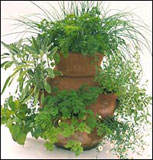Need some more plants?


Instead of splashing out why not try creating your own?
One of the joys of gardening is seeing your garden grow in sheer numbers of plants that you have produced yourself. Obviously there is always the time and the place for a quick trip to the garden centre – most of us can’t help ourselves!! Quite amazing that a space can always be found for something you’ve spotted at a “Journees des Plantes” as are held quite frequently during the autumn in Brittany.
Propagating plants, making more for nothing, is one of the most exciting aspects of gardening. Even the newest gardener will find that this is quite achievable and you never stop learning as you go either. The autumn is a great time to divide most herbaceous plants. Once flowering has finished, the plants will begin their period of dormancy. It’s all too easy to think of the garden in sleep mode during the autumn and winter, but in fact there is an enormous amount of change going on beneath the soil. There are a number of methods of division depending on the type of plant and the type of root system. One of the most useful methods, which I’ve concentrated on this month, is for clump forming plants.
Clump-forming plants, especially those congested with a woody crown, benefit hugely from division – you not only end up with more plants but healthier ones too. Lift the whole clump by using a fork and dig around the outside of the plant, easing it gently out of the soil. Once lifted, remove enough excess soil so that you can see where the roots and new shoots are so that each divided piece of plant has some of each. Some plants will pull apart quite easily. For others, you will need to use a couple of garden forks – placed back to back vertically in the middle of the plant, and by pulling the handles away from each other will force the plant in two. You may need to do this a few times to end up with more than just two plants. Occasionally with a very tough plant you may need to use a sharp knife – don’t worry about damaging it – as long as each new plant has a root and some shoots on it you will have no problems at all. Plants are amazingly resilient. A few of the plants you can try (there are loads!) are Heleniums, Asters, Phlox, Rudbeckias, Achillias, Helianthus, Monardas (Bergamot) and Alchemilla (Lady’s Mantle).
Cuttings: Now is the time to take hardwood cuttings of trees and shrubs and it really could not be simpler! Make sure you have a good sharp knife and prepare a small strip of ground by adding a bit of sharp sand to help with drainage if you have a very heavy soil. There are a wide variety of plants, which take reasonably easily and include honeysuckle, box, buddleia, forsythia, willow, weigela, roses, dogwood, escallonia and fig. Look for shoots that are this year’s growth and about the same thickness as a pencil. Make a cut just below a leaf bud and the top should be cut just above a leaf bud, so the cutting is between 15-40cm long. The tops of the cuttings should be cut on a slant and the bottoms straight – that way you won’t end up planting them upside down!
Depending on if you’d like your plant to have a single stem – you’ll need to rub off all but the top few leaf buds; leave them well alone if you’re looking for a bushy plant. To plant them find an area of the garden where your cuttings can be left till next autumn when they can be moved to their permanent home. Push a spade back and forth into the soil to make a slit trench. Add sharp sand to improve drainage and place cuttings 15cm apart and bury all but the top 5-7cm. Firm them well into the soil and water thoroughly. They may well need firming down again once frosts come and lift them to one degree or another.
Bon courage!
•With thanks to Miranda Bell
Share to: Facebook Twitter LinkedIn Email
More in brittany, centre, garden, learning
By FrenchEntrée
Leave a reply
Your email address will not be published. Required fields are marked *



